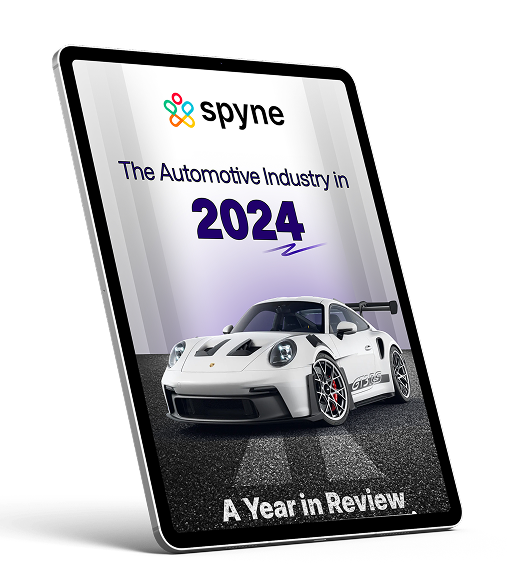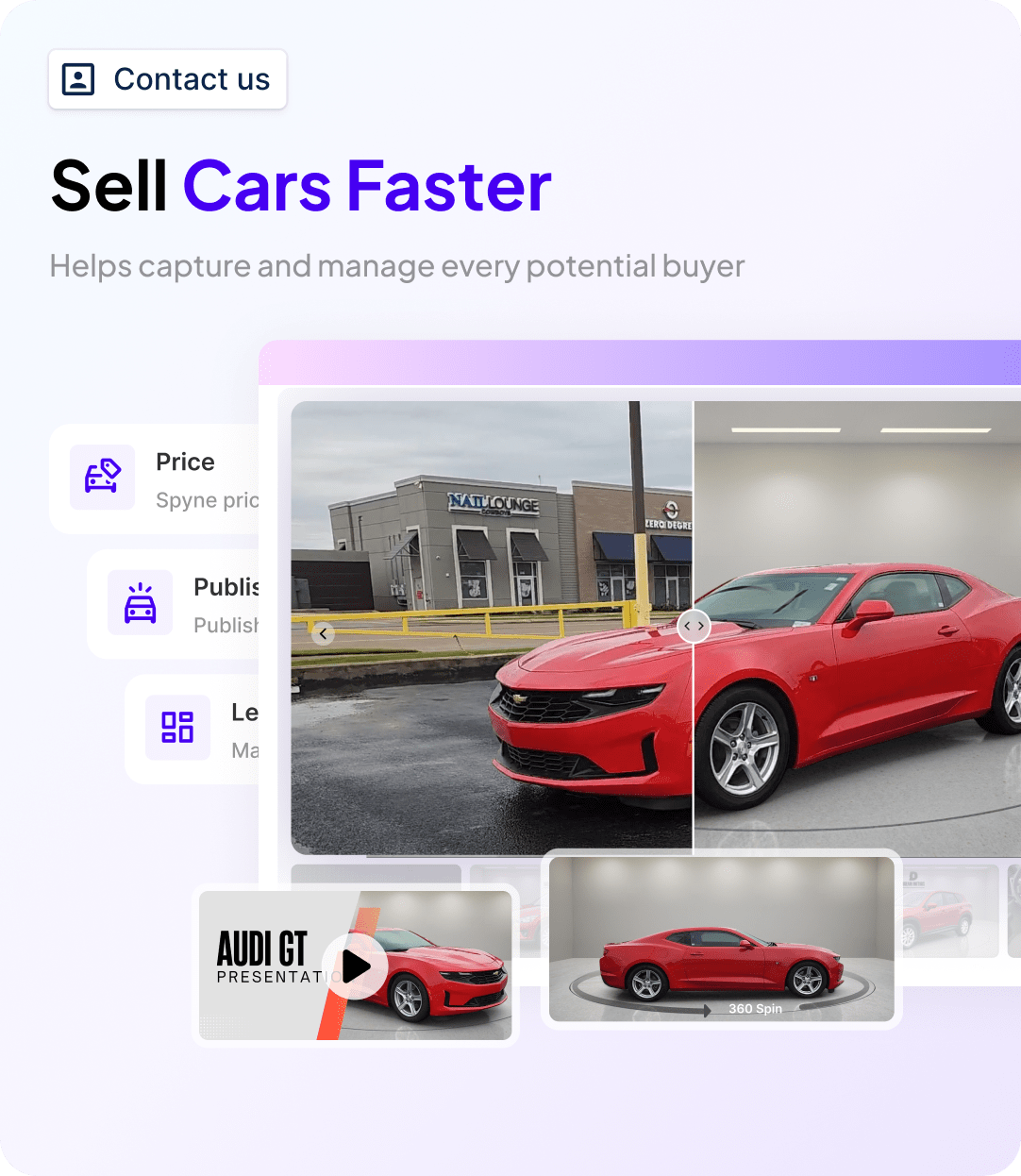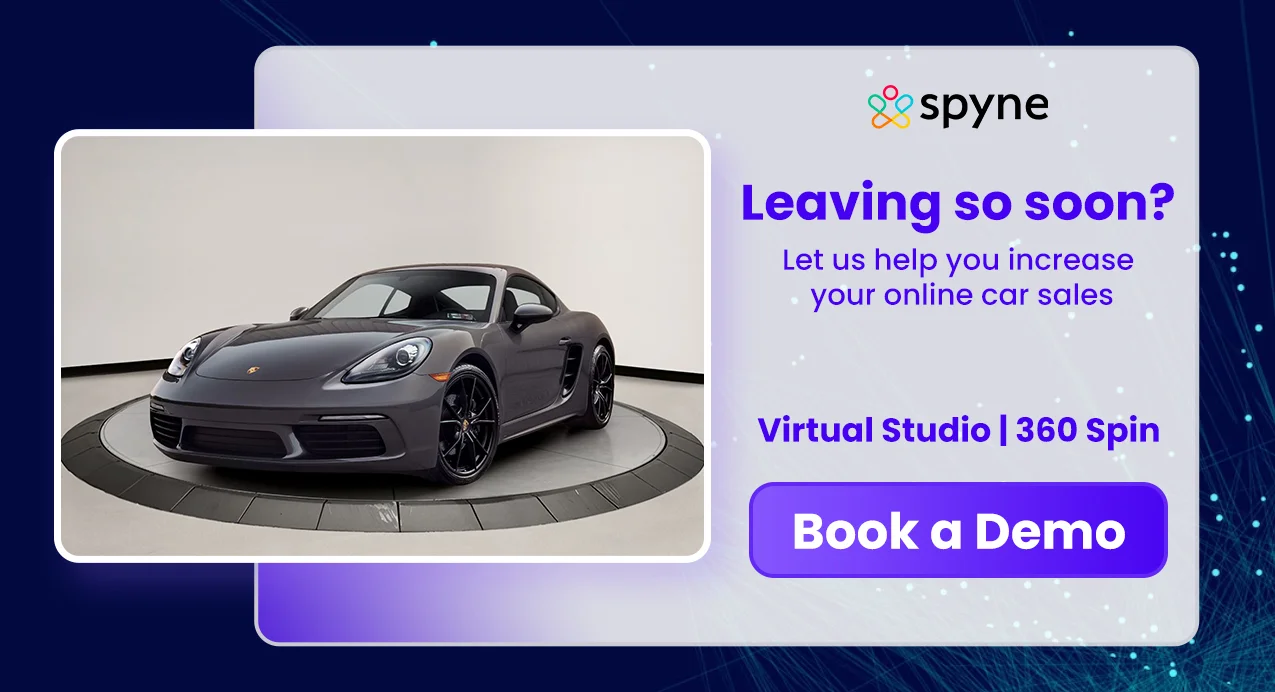AI car damage detection is eventually becoming a game-changer for automotive companies and insurers alike. These automotive businesses are leaning more towards computer vision and machine learning instead of manual inspections to spot the damage straight from the photos and videos.
So what is the payoff? Instant assessments, smoother claims processes, and significant cost savings.
The numbers back it up. A 2025 market report forecasts that AI-driven insurance claims processing will hit $2.76 billion by 2034, growing steadily at an 18.3% annual rate. Meanwhile, a 2024 study published in Applied Sciences reviewed real-world insurer cases and found that automated damage detection systems can identify both surface and structural damage with up to 90% accuracy. These tools speed up claims, cut down on fraud, and improve transparency: all big wins for insurers and fleet operators.
For insurers, AI means quicker claim resolutions with less need for adjuster involvement. Auto repair shops benefit from clear, consistent damage reports and faster diagnostics. Fleet managers get reliable, scalable inspections across large numbers of vehicles.
Overall, this technology is helping the industry keep up with growing demand while slashing overhead costs. It’s a win-win for everyone involved.
What is Car Damage Detection?
Car damage detection is an automated vehicle inspection method that utilizes artificial intelligence (AI) to evaluate and analyze vehicle damage via digital images. AI car damage detection uses deep learning, computer visions, and intricate algorithms to figure out different kinds of damage of vehicles.
Vehicle damage detection systems transform the conventional inspection procedure for various stakeholders:
- Insurance firms simplify the handling of claims.
- Auto dealerships improve the effectiveness of vehicle evaluation.
- Fleet managers enhance maintenance planning.
- Car manufacturers strengthen their quality assurance.
- Vehicle owners obtain immediate damage assessments.
In contrast to labor-intensive manual checks, vehicle damage inspection apps powered by AI provide quick, reliable outcomes and offers numerous significant benefits:
- Automated evaluation of damage in just minutes.
- Steady and impartial examination
- Thorough electronic record-keeping
- Accurate assessment of repair expenses
- Simplified claims handling
- Decreased operational expenses

How AI Car Damage Detection is Transforming the Automotive Industry
AI Car Damage detection reduces human involvement and makes the damage inspection process more efficient which has greatly impacted the automotive industryidentify all kinds of damage.
- Insurance Claims: AI helps speed up the damage assessment process so that insurance companies can process the claims quickly. Photos of damage are analysed to generate accurate repair estimates.
- Enhanced Vehicle Resale Value: AI-driven damage reports offer detailed, transparent histories of a vehicle’s condition, which can boost buyer confidence in used cars.
- Predictive Maintenance: AI can predict areas prone to wear and tear before they go on to become significant issues. This helps in proactive maintenance, thus, improving longevity and reducing unexpected breakdowns.
How AI car damage detection works
Imagine a system that can instantly spot dents, scratches, or cracks on your car just by looking at a photo and do it better than most people. Modern car damage detection technology uses smart imaging and machine learning to find the damage and figure out how bad it is.
Here’s what goes behind it:
Seeing with Computer Vision
First up, the system uses computer vision to scan the images. It looks for anything out of place like a dent, a scratch, or a crack by examining the textures and shapes on your car’s surface. Think of it as the system’s “eyes,” spotting trouble spots right away.
The Power of Neural Networks
Under the hood, these systems rely on something called Convolutional Neural Networks (CNNs). These are a type of AI trained on thousands of car damage photos. Because of this training, they can recognize damage even if the picture is taken in tricky lighting or from weird angles.
Zooming in with Image Segmentation
The “zoom-in” step allows the automaker to focus on what matters and isolates the exact damaged area from the rest of the image.
Classifying and Scoring the Damage
Next, the AI decides what kind of damage it is, maybe a scratch, a dent, a cracked bumper, or a broken light, and assigns a severity score. This score is super useful because it follows the rules insurers use, meaning the info can plug right into claims systems without a hitch.
Smooth Image Processing Pipelines
Before any of this happens, there’s a behind-the-scenes process that handles the photos. The AI automatically checks if the images are clear enough, adjusts brightness, removes noise, and resizes them so everything is standardized for analysis.
Smart Connections with IoT and Telematics
Even cooler? When connected to devices in your car, these AI systems can jump into action automatically. Say your car’s telematics system detects a collision, the AI can then request photos instantly, speeding up the whole insurance claim process.
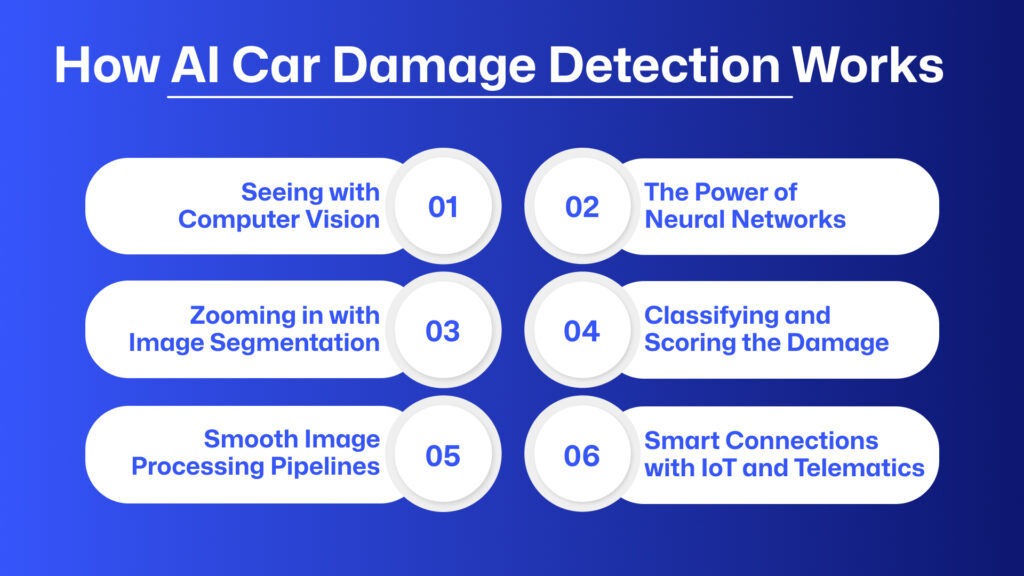
Why is Car Damage Detection Useful?
Vehicle damage detection systems have completely changed the way businesses and everyday people check for car damage. These automated tools make inspections faster and more accurate, cutting down the long hours that manual checks usually take; all while delivering consistent and trustworthy results.
Insurance companies find these tools especially useful because they can process claims much quicker and with greater precision using damage inspection apps. Fleet managers benefit too, as the software helps them schedule maintenance ahead of time and keep their vehicles on the road longer. Rental companies use these systems to create clear, standardized records of a car’s condition when customers pick up and return vehicles, which helps avoid disputes about who’s responsible for any damage.
Dealerships also gain from this technology by keeping detailed, transparent records of vehicle conditions, which builds trust during used car sales.
What Are the Real-World Uses of Car Damage Detection Systems?
Car Damage Detection Systems are becoming a crucial tool across the automotive world, helping in everything from safety to managing large fleets. Here’s a breakdown of how these systems are actually being used:
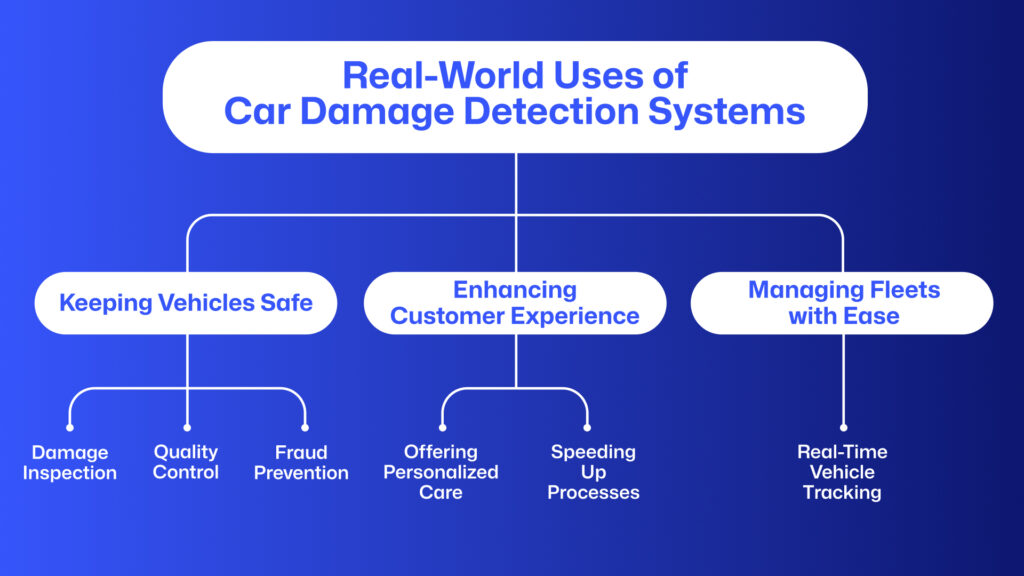
Keeping Vehicles Safe
Safety is a top priority for car makers, and damage detection systems play a big role in making sure vehicles are in good shape and drivers stay safe. Here’s how:
- Damage Inspection
Repair shops use these systems to get a clear picture of any damage a car has sustained. Powered by advanced tech like pattern recognition and machine learning, these tools can spot even subtle issues. That way, manufacturers know exactly what repairs are needed and can give accurate cost estimates.
- Quality Control
Cars often change hands between different companies during production or servicing. Damage detection systems help ensure the vehicle is in great condition at each stage. This not only helps avoid unnecessary repair costs but also tracks when and where damage happened, providing transparency.
- Fraud Prevention
Insurance companies benefit a lot from these systems. Using sophisticated algorithms, the technology can spot inconsistencies or signs of tampering in vehicle images, helping insurers catch fraudulent claims early. This means fewer fake claims slipping through and lower costs overall.
Enhancing Customer Experience
Keeping customers happy is key, and damage detection systems make that easier by:
- Offering Personalized Care
Companies can train these systems to assess damage based on specific standards, giving tailored repair and maintenance advice for each vehicle’s unique condition.
- Speeding Up Processes
Since these systems are automated, inspections and responses happen much faster. Quicker service means happier customers, plus, companies save money by cutting down manual work.
Managing Fleets with Ease
For companies handling many vehicles, damage detection is a game-changer for fleet management.
- Real-Time Vehicle Tracking
When linked with fleet management software, damage detection helps monitor each vehicle’s condition live. Fleet managers can see when repairs are needed, plan maintenance better, and avoid costly downtime.
This is especially handy for rental car companies, which need to keep tabs on the condition of their vehicles before and after each rental. It helps them decide who’s responsible for damages and what costs apply, keeping everything fair and transparent.
Types of AI Car Damage Detection
Modern vehicle damage inspection systems come in various forms to meet different industry needs.
- Mobile-based solutions allow users to capture and analyze damage using smartphone cameras, making them ideal for field inspections and customer self-service.
- Fixed inspection stations utilize high-resolution cameras and controlled lighting for detailed car damage assessment in professional settings.
- Drive-through systems enable rapid fleet inspection with automated photography and analysis. Computer vision-based solutions can detect and classify different types of damage, from minor dents to major structural issues.
- Advanced recognition systems incorporate 3D modeling to provide comprehensive damage visualization. Some platforms specialize in specific damage types, such as automated dent detection or paint scratch analysis.
- Enterprise-level systems often integrate with existing business management software, offering end-to-end solutions for damage documentation, repair estimation, and claims processing. These systems continue to evolve with improved accuracy and expanded capabilities.
Top AI Car Damage Detection Providers in 2025
Many AI inspection services are actively revolutionizing car detection by leveraging advanced technologies for faster and more accurate car damage recognition. Here are some of those providers:
| Tool | Description |
| Spyne | A leading brand that offers AI-based damage detection with real-time support and guidance through mobile-friendly scanning. It provides both complete and partial vehicle assessments on any device. |
| Tractable | Highly used in the insurance industry, this car damage app uses machine learning to identify vehicle damage from images, helping insurers automate claims and repairs. |
| Ravin | This one specialises in car-sharing platforms. It uses AI damage detection to offer real-time assessments, hence preventing fraud and improving risk management. |
| UVEye | Another vehicle damage app powered by AI is UVEye which effectively captures minor or major vehicle damage and anomalies using high-definition cameras and sensors for detailed assessments. |
| ProovStation | It uses AI and 3D scanning technology for quick and precise damage detection, primarily for car dealerships and rental companies. It focuses on car damage image recognition using AI and 3D scanning modules to identify potential damages quickly and efficiently. |
| Inspektlabs | Majorly focuses on object detection and segmentation techniques to trace and categorise various types of vehicle damage. |
| DingGo | Delivers an AI-assisted damage detection with real-time repair quotes, facilitating a faster repair process for insurers and repair shops. |
| PitStop | AI-powered vehicle diagnostics tool that helps detect and report damages ideal for fleet management and car rentals. |
It is essential to understand that a vehicle damage inspection app is not just helpful for the dealerships, it’s also equally valued in the insurance and servicing space.
Advanced Vehicle Diagnostics with AI: Top 6 Technologies for AI Car Damage Detection
It’s not wrong to say that AI Car Damage Detection is revolutionizing vehicle diagnostics by making object detection and maintenance simpler, more precise, and more efficient. But what technologies are actually making vehicle damage inspection systems a reality? Here are seven key technologies that are making it possible:
Machine Learning (ML)
ML models are the core of this technology. By analysing vast amounts of car damage detection data like images, videos etc. these modules actually determine the damage. It works by identifying patterns in a car and finding unusual anomalies. The more information it gets the better this technology will become.
Deep Learning
An extension of ML, car damage detection using deep learning algorithms is the brain of this whole affair, mimicking that of a human. Deep learning bots are trained by analysing thousands of damaged and clean car images allowing them to detect not just prominent damage like large dents, but also minor issues such as scratches or paint irregularities.
Computer Vision (CV)
In layman’s terms, CV enables machines to see and interpret used car images. For car dent detection and other damage detection, CV becomes even more crucial as it works in tandem with deep learning to detect even the smallest discrepancies in a vehicle’s surface, such as dents or slight color variations.
Predictive Analytics
Car damage detection using machine learning and AI-powered predictive analytics utilizes data from different vehicle sensors to predict potential damage and failures. By constant monitoring of various aspects like the engine temperature, vibrations, and driving patterns, the system can notify dealerships of the issue before it escalates into costly repairs or worse potential breakdown.
Natural Language Processing (NLP)
NLP technology enables AI systems to decode human language, making it simpler for dealerships to report any damage. An AI car damage detection online can process the information and categorize the issue/damage by type and location. NLP technology today is making insurance claim processing simpler for companies.
Sensor Fusion
An AI car damage detection app relies on sensors like cameras, radar, lidar, and ultrasonic sensors to conduct a comprehensive evaluation of the car condition ratings. Backed by AI, these sensor fusion provides real-time insights, enabling instant detection of damage or anomalies.
A Step-by-Step Guide to How Spyne’s AI Car Damage Detection Works
Spyne’s AI car damage detection for free works by simplifying and automating the entire vehicle inspection process with its user-friendly platform. Here’s how it works:
- Access the Platform: Customers get a link to the platform where they can pick between a full vehicle scan or a partial scan of damaged areas.
- Mobile AI Scanning: Spyne AI works on any device, including phones. The system guides users step-by-step to take clear, accurate pictures of the vehicle. This ensures a smooth scan without the need for tech know-how.
- Real-Time Feedback: As users snap photos, the AI picks the best images and makes sure all needed details are captured.
- Cloud AI Processing: After users upload the images and first assessment to the Cloud, Spyne’s advanced AI does a deeper analysis by finding more damage, evaluating the car’s state and safeguarding personal information of the owner and vehicle.
- Repair Estimates and Anti-Fraud: The AI offers in-depth repair advice cost projections and does an anti-fraud check to ensure correctness.
This smoother method makes things clearer, cuts down on time, and gives people more trust in figuring out the damage.
What sets Spyne’s AI Car Damage detection Apart from the Competition?
Spyne AI’s exclusive damage detection technology is known for being the most convenient and accurate. It has gone through rigorous testing on millions of real vehicle images that have been captured organically through cameras and the inspection app. Also, with Spyne’s state-of-the-art vehicle modeling AI, the company is capable of creating a unique model of each vehicle without even seeing the vehicle before. This indicates that the app is not required to store thousands of 3D vehicle models. These would need to be updated for each new model, spec, and trim. Additionally, the platform combines Mobile AI and Cloud AI, meaning it can provide instant results, reports, guidance and give feedback to users whilst also carrying out more complex and detailed analyses of the car’s condition, including giving repair costs.
While there are many software available, Spyne is making an effort to make real-time vehicle damage recognition easy for dealerships. Here’s how:
Spyne’s system provides a unique easy-to-use smart vehicle damage analysis that efficiently detects any forms of damage on vehicles, including minor scratches to major dents. And what’s surprising is that all of this is done in just one minute! Has it ever been easier than with this solution? Here’s a closer look at how this vehicle damage detection using ai will work on your car:
- Your vehicles will pass through a specially designed light tunnel that houses advanced optical cameras.
- These high-resolution cameras, aligned with sophisticated software, systematically identify every dent an anomaly on the vehicle, resulting in a detailed report categorising the damage’s extent.
- The data collected about the vehicle’s condition in this phase is compressed and securely stored in cloud storage, ensuring both data security and easy access.
What Spyne’s AI Car Damage Detection Can Detect?
Spyne’s vehicle damage inspection system can detect a host of defects and damages on a car. With a comprehensive tracking and processing system, it generates reports with the most detail. Here are some of the many damages that Spyne’s AI car damage detection app can identify:
- Light damage (Small damages like scratches on the body)
- Light damages on tyres (Scratches on alloy wheels)
- Medium damage (Large scratches or dents on the body)
- Heavy damage (Car crashes)
- Hidden damage (Any unidentifiable damage in the underbody)
Benefits of Using Spyne’s AI Car Damage Detection
Spyne’s AI car damage detection online offers a series of benefits for companies in the automotive business. Here are some benefits that it offers.
- Automates damage detecting even hidden damages on a car
- Automated and IT-supported damage notification via API, Slack, email
- Detailed damage information and report for quick resolution and attribution
- Powerful automation capabilities for swift action on severe damage
- Web interface for efficient accident tracking and management
- Provides damage history per vehicle for easy identification of new and old damage
Conclusion
AI car damage detection is transforming the used car industry, making manual inspections a thing of the past. By using smart AI algorithms, these platforms identify minor or even hidden damages that human eyes may miss. If you’re considering trying out an AI car detection image processing at zero cost, you must definitely consider using Spyne. It not just offers a software and AI capabilities but also great analysis and back-end support.



